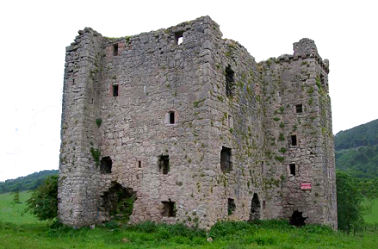Eaves Wood
OS Grid ref:-
 Eaves Wood is situated at Silverdale, an Area of Outstanding Natural Beauty (AONB) on the eastern edge of Morecambe Bay in Northern Lancashire.
Eaves Wood is situated at Silverdale, an Area of Outstanding Natural Beauty (AONB) on the eastern edge of Morecambe Bay in Northern Lancashire.
An area of ancient woodland, Eaves Wood is the property of the National Trust and is characterised by limestone scars and pavements, which are a feature of the landscape in the Silverdale area.
The limestone with its pockets of thin soil supports numerous yew trees, other species to be found there include ash, beech, birch, hawthorn, hazel,holly, larch, lime, oak and pine.
The Pepperpot, a prominent local landmark, sits stoutly at the summit of Castlebarrow, at a height of over 250 feet above sea level. Originally known as the Pepperbox, it is a circular roughstone tower, rising to about twenty feet high and is topped by a conical roof. The folly was constructed for the Hebden family, the then owners of Castlebarrow and was built in 1887 to commemorate the golden jubilee of Queen Victoria. The summit of Castlebrow offers superb views over Morecambe Bay, including Heysham, Lancaster and the Ashton Memorial, in clear weather conditions it is possible to see as far as the Bowland Fells and Ingleborough in the Yorkshire Dales.
 Arnside Tower (pictured right) stands in picturesque ruins between Castlebarrow and nearby Arnside Knott. Once a defensive structure, situated between the sea and marshes, it was built by the De Broughton family in around 1340 as a defense against Scottish reivers, and was damaged by fire in 1602.
Arnside Tower (pictured right) stands in picturesque ruins between Castlebarrow and nearby Arnside Knott. Once a defensive structure, situated between the sea and marshes, it was built by the De Broughton family in around 1340 as a defense against Scottish reivers, and was damaged by fire in 1602.
It has suffered further deterioration over the centuries, including damage caused by a severe storm in 1884, which almost totally destroyed the internal cross wall, causing the South West wall to collapse. At present little more than a shell remains, although it still retains its fireplaces and sections of newel staircases.
Pele Towers were constructed in medieval times to provide protection from Scots raids, and in north-west England between the River Lune and the Scottish border over one hundred were built. Peles were smaller, less well fortified, then castles.
Arnside Tower is unusual in that it had four storeys, while most pele towers had three. The ground floor contained store rooms and a dairy, while steps led up to the entrance, which was on the first floor. Fireplaces and garde robes (latrines) were built into the thickness of the wall.
